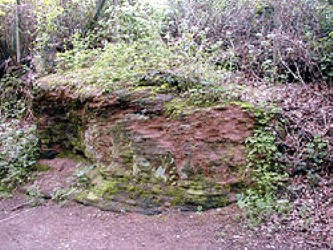Menu
The Ridge
Introduction
Alexandrina Plantation Local Nature Reserve (LNR) and Sandy Lane Public Open Space LNR sit just north of the A52 Nottingham to Derby road, approximately 4 miles to the west of Nottingham. It lies between the suburbs of Wollaton, Bramcote Hills and Lenton Abbey.
- Ordnance Survey grid reference: SK 518 386
- 'what 3 words' Alexandrina Plantation LNR main entrance: guilty.money.bind
- 'what 3 words' Sandy Lane Public Open Space LNR main entrance: flown.diner.chimp
To get a good view of the LNRs and surrounding areas, have a look at the aerial map below.
A map showing the various routes across the LNR is available HERE.
The area is also designated as a Grade II Site Important for Nature Conservation (SINC) and an 'Area of Restricted Development'. Approximately one third of the LNRs is privately owned, with the remainder mostly owned by Broxtowe Borough Council. Ownership is shown on the map below.

Geology
 The substrate underlying the Ridge is known as 'Bunter Sandstone Pebble Beds' which is a yellow/buff-coloured sedimentary rock, characterised by multi-coloured pebbles embedded in the strata. These pebbles consist of various types of rock, with quartzite and vein quartz predominating. The term 'Bunter' is of German origin and means 'bright-coloured'.
The substrate underlying the Ridge is known as 'Bunter Sandstone Pebble Beds' which is a yellow/buff-coloured sedimentary rock, characterised by multi-coloured pebbles embedded in the strata. These pebbles consist of various types of rock, with quartzite and vein quartz predominating. The term 'Bunter' is of German origin and means 'bright-coloured'.
The pebble beds were laid down 246 to 251 million years ago in the Triassic Period when much of the Midlands was a low-lying desert plain. In the Nottingham area, this rock extends to a depth of about 60 metres. Erosion over the years has created the present ridge lying between the 50m and 75m contours.
Due to the topography of the site, virtually all water input is via rainfall which quickly soaks away into the porous bedrock. Quick drainage means the site is low in nutrients as they are leeched straight down into the ground.
History
Little is known about the history of the site, but the general area of Bramcote was enclosed by Act of Parliament in 1771 and the land was put over to agricultural use, possibly the grazing of stock. The main woodland (Alexandrina Plantation) appears to have been planted between 1836 and 1880, possibly to commemorate the marriage of Edward VII to Princess Alexandra in 1863. Many of the trees appear to have been coppiced, possibly during World War Two when wood have been scarce.

The LNR was part of Bankfield Farm until the the land was put over for residential development in the 1950's. The Rosegrower pub used to occupy the site of the former farm buildings but was demolished in 2009; a care home now sits at that site at the corner of Bankfield Road and Sandringham Drive. The Sandy Lane bridleway, running along the east side of the site, follows the Nottingham City boundary and was once the only route to the village of Wollaton, from the Nottingham/Derby road (the present A52).
On each side of the bridleway (light.grow.scary) are remnants of hedgerows marking the boundary between the parishes of Wollaton and Bramcote. These hedges contain some of the oldest trees and shrubs on the site.
A cast iron boundary marker is located towards the southern end of the bridleway eaten.marble.backup. This dates from 1933 and commemorates the time when the City of Nottingham was extended to incorporate the parish of Wollaton.
Although the Broom scrub in the centre of the site is not of direct historical importance, the name 'Bramcote' is derived from 'cottages in the Broom', and so may be considered to be indicative of the area long ago when the first Anglo-Saxon settlers arrived in the area.